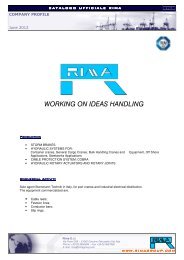Rima Hydraulic Systems
Rima Hydraulic Systems
Rima Hydraulic Systems
You also want an ePaper? Increase the reach of your titles
YUMPU automatically turns print PDFs into web optimized ePapers that Google loves.
Typical data gru<br />
(valid for cylinders put on the fixed end of ropes)<br />
For spreader positioning:<br />
Force 120kN<br />
Pressure 150 bar<br />
Speed adjustable from O to 28 mm/s<br />
For antisnag:<br />
Force 150 kN<br />
Pressure 180 bar<br />
Initial speed 4 m/<br />
Possible executions<br />
<strong>Hydraulic</strong> Unit<br />
- Open<br />
- Closed with cover<br />
- Closed with hinged doors<br />
- Closed-packed execution in which the<br />
cylinders are already connected to<br />
hydraulic unit and ready to work<br />
Speed:<br />
Pump:<br />
- Fixed<br />
- Double<br />
- Adjustable continuously (with or<br />
without feed back retroaction)<br />
- Single with fixed flow<br />
- Single with variable flow<br />
- Double (one for stand-by) with variable<br />
flow<br />
Antisnag valves:<br />
- With loss: they are more ready if snag<br />
happens but a continuously position<br />
check is required<br />
- Without loss<br />
WWW.RIMAGROUP.COM<br />
T-L-S ANTISNAG SYSTEMS<br />
Operating<br />
TLS movement:<br />
They are driven by operator. The stroke indicators<br />
assembled inside the cylinders act as reference for<br />
stop position of cylinders. The movement speed can<br />
be fixed or variable according to required solution.<br />
It is possible to memorise and to find again<br />
automatically some positions of stability by stroke<br />
indicators.<br />
Antisnag movement:<br />
If the spreader bumps into hold of ship or into other<br />
obstacle, the pressure into cylinder increases. When<br />
pressure value exceeds a settled value (usually 25%<br />
more than max working value) the antisnag valve<br />
opens itself very quickly (opening time as not to be<br />
major than 50 mms) allowing oil to flow in pressure<br />
and bump energy to be absorbed. At the same time<br />
suitable load cells stop the lifting motor.<br />
Ropes tensioning Cylinders<br />
The a.m. hydraulic unit can often feed other cylinders<br />
(usually two cylinders) that keep in tension the trolley<br />
translation ropes at a force fixed value.<br />
3 <strong>Rima</strong> Technology



